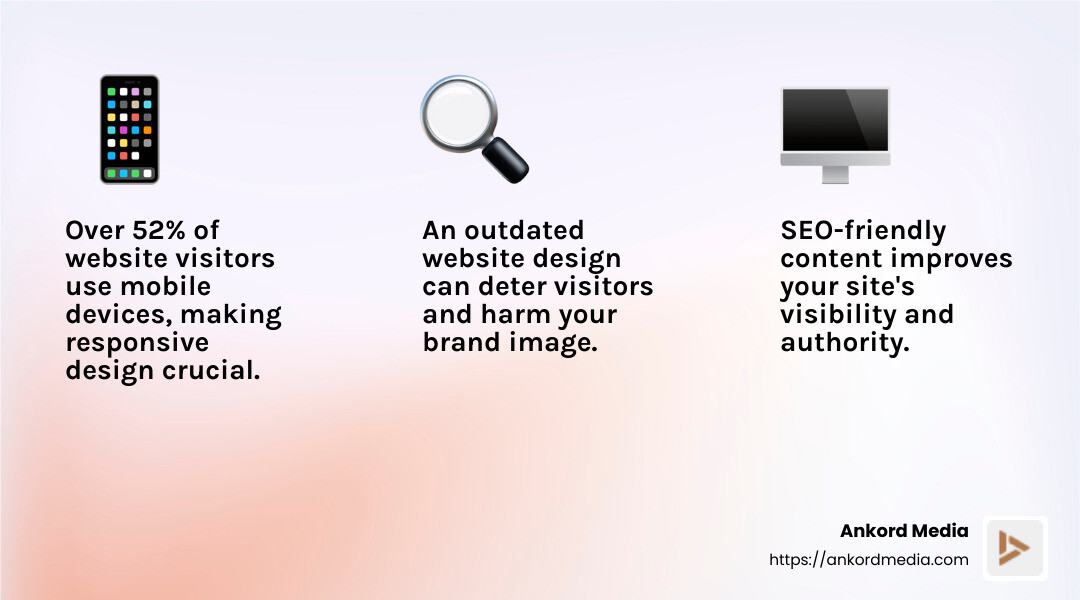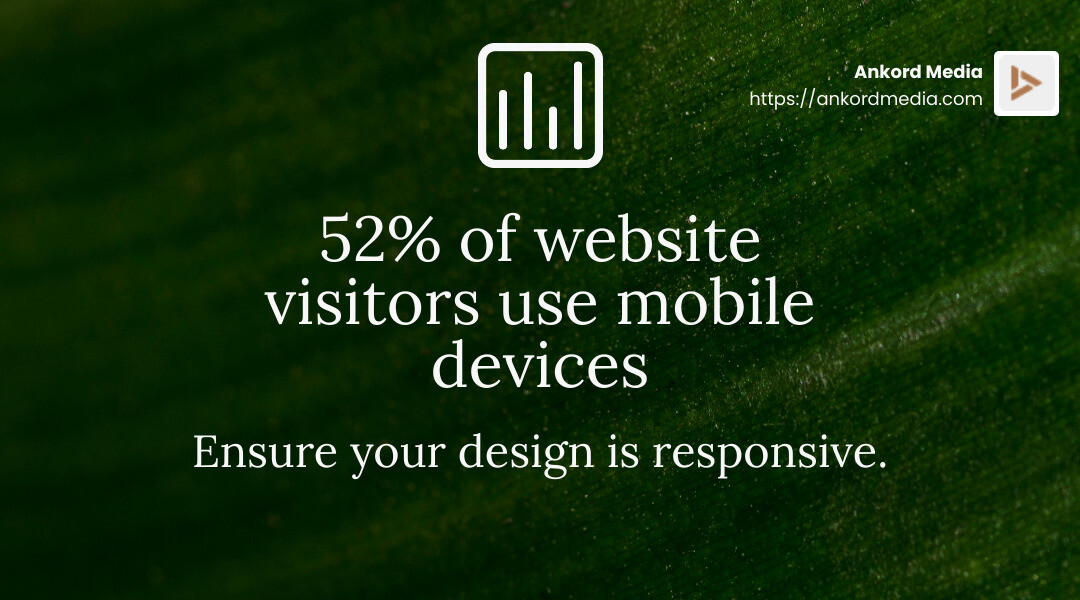

Modernize old website—it's a phrase that many businesses and entrepreneurs encounter as they face the challenges of an evolving digital landscape. An outdated website can change how a brand is perceived, negatively affecting its competitiveness and relevancy. But how can you quickly breathe new life into your digital presence? Here’s a quick answer:
- Responsive Design: Ensure your site looks great on any device, especially mobiles.
- Full-Width Layout: Update to a full-width layout to use the entire screen.
- SEO-Friendly Content: Optimize your text for better search engine visibility.
- Visual Updates: Replace dated images with fresh, high-resolution photos.
- Engaging Media: Integrate videos and interactive media to captivate users.
In today's world, where over half of website traffic comes from mobile devices, adapting to digital change is crucial. Sticking to an old design is like living in the past—it doesn't resonate with modern users and might hurt your brand. Yet, modernizing can be as simple as making a website responsive or updating the visuals to full-width for that 2023 look.
I’m Milan Kordestani, a passionate entrepreneur and the founder of Ankord Media. My team and I excel at helping businesses transform their online identities, making the process of modernize old website a seamless transition toward innovation and growth. Let me take you on a journey where your vision meets cutting-edge digital experiences.

Quick look at modernize old website:
- upgrade your old website with a fresh redesign
- website redesign for improved ux
- website redesign to improve outdated ui and customer journeys
Assessing Your Current Website
Before you dive into modernizing your website, assess what you currently have. This process involves a thorough content review, design evaluation, and competitor analysis. These steps will help you understand what works, what doesn't, and what needs a fresh touch.
Content Review
Start by examining the content on your website. Is it up-to-date and aligned with your brand's current voice and values? Keeping your content relevant builds trust with your audience and improves your authority in your field.
- Update Your Content: Refresh your pages to reflect your current services, team, and values. The About page is a great place to start.
- SEO-Friendly Content: Ensure your text is optimized for search engines. Use keywords strategically to improve your site's visibility.
Design Evaluation
A website that looks outdated can deter visitors and harm your brand's image. Evaluate your design elements to see if they align with modern trends.
- Responsive Layout: Over 52% of website visitors use mobile devices. A responsive design ensures your site looks great on any screen.
- Visual Elements: Ditch old design trends like gradients and bevels. Opt for solid colors and updated typography for a cleaner look.

Competitor Analysis
Understanding your competitors' strategies can offer valuable insights into industry standards and expectations.
- Design Trends: Look at the design elements your competitors use. Are they using full-width layouts, interactive media, or real images?
- Content Strategy: Analyze their content strategy. What topics do they cover? How frequently do they update their blogs or social media feeds?
By conducting a thorough assessment of your current website, you can pinpoint the areas that need improvement. This sets a solid foundation for the modernization process, ensuring that your updates are strategic and effective.
Next, let's explore strategies to modernize your website, focusing on responsive design, multimedia elements, and SEO optimization.
Strategies to Modernize an Old Website
Once you’ve assessed your current website, it's time to dive into strategies that can effectively modernize an old website. The key areas to focus on are responsive design, multimedia elements, and SEO optimization. Each plays a crucial role in bringing your site up to date and enhancing user experience.
Responsive Design
In today's digital landscape, a responsive design is not just a trend; it's a necessity. With over half of website traffic coming from mobile devices, ensuring your site adapts seamlessly to different screen sizes is crucial.
- Mobile Optimization: Ensure your website design adjusts smoothly across all devices—smartphones, tablets, and desktops. This might require reworking HTML and CSS, but the effort pays off in user satisfaction and engagement.
- Fluid Layouts: Transition from static to full-width designs. This modern approach offers scalability and a sense of completeness, enhancing user experience.

Multimedia Elements
Incorporating multimedia elements can significantly improve your website's appeal and engagement levels.
- Real Images and Videos: Replace outdated stock photos with authentic images and engaging videos. This not only humanizes your brand but also keeps visitors on your site longer.
- Interactive Media: Add elements like slideshows or interactive infographics to make your content more engaging. These tools can help convey complex information in a digestible format.
SEO Optimization
A modern website is not just about looks; it must also perform well in search engine rankings. Optimizing your site for SEO is essential for driving organic traffic.
- Keyword Integration: Use relevant keywords naturally throughout your content. This boosts your visibility on search engines.
- Meta Tags and Descriptions: Ensure every page has a unique meta title and description. These elements are crucial for search engine indexing and user click-through rates.
- URL Structure: Keep URLs clean and descriptive. They should reflect the content of the page to improve both user and search engine understanding.
By focusing on these strategies, you can effectively modernize your old website, making it more engaging, accessible, and visible to your target audience.
20 Ways to Modernize Your Website
Ready to bring your website into the modern era? Here are 20 actionable steps to transform your online presence.
1. Full-Width Design
Switch to a full-width design to eliminate outdated static layouts. This approach spans the entire screen, creating a more immersive experience. It's a quick win that instantly makes your site feel modern.
2. Responsive Layout
Ensure your site works seamlessly on all devices. With over 52% of web traffic from mobile, a responsive layout isn't optional—it's essential.
3. Logo Update
A fresh logo can refresh your brand. Aim to update it every five years to stay current and relevant.
4. Content Refresh
Keep your content aligned with your brand's current voice and values. Start with the About page, and ensure all information is up-to-date.
5. Real Images
Ditch the stock photos. Use real images of your team and workspace to humanize your brand and build trust with visitors.
6. SEO-Friendly Content
Optimize your content for search engines. Use keywords naturally, and ensure each page has unique meta tags and descriptions.
7. Useful Footer
Transform your footer into a resource hub. Include contact information, quick links, and social media profiles.
8. Blog Content
Regularly updated blog content can drive traffic and establish your brand as an authority in your field.
9. Call-to-Actions (CTAs)
Incorporate clear CTAs that guide users to take action, whether it's contacting you or signing up for a newsletter.
10. Stat Tracking
Implement analytics tools to track user behavior. This data is invaluable for ongoing improvements.
11. Modern Design Trends
Stay away from outdated design elements like gradients and bevels. Accept simplicity and clean lines.
12. Instagram Feed
Integrate an Instagram feed to showcase your latest posts and engage visitors through visual content.
13. Updated Typography
Choose modern, readable fonts. Typography sets the tone for your site and impacts readability.
14. Solid Colors
Replace textures and patterns with solid colors for a clean and contemporary look.
15. Favicon
Add a favicon to your site for brand recognition in browser tabs and bookmarks.
16. Spaced Elements
Use white space effectively. Proper spacing improves readability by up to 20%.
17. Videos
Incorporate videos to make your content more engaging. They are a powerful tool for storytelling and product showcases.
18. WordPress Theme
Consider a new WordPress theme if your current design feels outdated. Many themes offer built-in modern features.
19. Rebuild Website
If your site is severely outdated, a complete rebuild might be the best option. This ensures alignment with current web standards.
By implementing these strategies, you can modernize your old website and significantly improve user experience and engagement.
Next, let's explore how to implement modern design trends effectively.
Implementing Modern Design Trends
To modernize an old website, it's crucial to incorporate current design trends that resonate with today's users. Here's how you can start changing your site with some impactful changes:
Hero Images
A hero image is your website's visual handshake. It's a large, eye-catching image at the top of your page that sets the tone and gives visitors an instant understanding of your brand. A high-quality, relevant hero image can establish professionalism and authority. For WordPress users, plugins or themes often make it easy to add or update these images. If your site is HTML-based, consider a responsive redesign to simplify future updates.
Background Colors
Think of changing your website's background color like giving your home a fresh coat of paint. It's a simple way to update the look and feel without much hassle. If your site is dark, try lighter colors for a cleaner, more modern vibe. For those with a white background, adding a subtle accent color can create visual interest. Depending on your site's construction, you might need to tweak the code, but it's far easier than a full redesign.
Sidebar Removal
Sidebars can clutter your homepage and distract users from your main message. While they serve a purpose on eCommerce sites, for most websites, removing the sidebar can create a cleaner, more focused user experience. This allows your visitors to concentrate on the content and actions you want them to take, like signing up for a newsletter or exploring your services.
Modern Elements
Incorporate elements that reflect current web design trends. This might include using minimalist icons, interactive buttons, or subtle animations that improve user engagement without overwhelming the visitor. Consider integrating dynamic elements like slideshows or galleries—just avoid outdated technologies like Flash. The goal is to create a site that feels fresh and relevant, aligning with user expectations and modern web standards.
By implementing these modern design elements, you'll not only improve the aesthetics of your website but also improve its functionality and user experience. Ready to dive deeper into the technical side of website updates? Let's move on to frequently asked questions about modernizing old websites.
Frequently Asked Questions about Modernizing Old Websites
How to update a website?
Updating a website involves two main aspects: content updates and design refreshes. Start by reviewing your content to ensure it aligns with your current brand message and offerings. Outdated information can confuse visitors and damage your credibility.
Next, focus on a design refresh. This doesn't mean you need a complete overhaul. Small changes like updating typography, replacing old stock photos with real images, and adding new color schemes can have a big impact. According to research, even minor design tweaks can modernize your site and improve user experience.
What is a 301 redirect?
A 301 redirect is a permanent URL redirect from one webpage to another. It's crucial for maintaining SEO when you change page URLs during a website revamp. This ensures that search engines and users are directed to the new page location seamlessly.
For example, if you update your website structure, a 301 redirect will help preserve your search engine rankings by transferring the SEO value from the old URL to the new one. This minimizes the risk of losing traffic and keeps your site’s visibility intact.
How much does a website redesign cost?
The cost of a website redesign can vary widely based on several factors, including complexity and who you hire. If you choose to work with a freelancer, costs can range from a few hundred to several thousand dollars, depending on their expertise and the scope of your project.
More complex sites, especially those requiring custom development or extensive SEO optimization, may cost more. It's important to get detailed quotes and understand what each package includes. Consider not just the upfront costs but also the long-term value of investing in a modern, user-friendly website that aligns with your business goals.
Conclusion
At Ankord Media, we believe that a website is more than just a digital space—it's a powerful tool for storytelling and brand building. As experts in strategic branding and digital experiences, we partner with visionary clients to transform their bold ideas into tangible success.
Modernizing an old website is not just about keeping up with trends. It's about crafting a digital experience that resonates with your audience and aligns with your brand's core values. By focusing on authentic customer connections and impactful storytelling, we help our clients create websites that are not only visually appealing but also strategically sound.
Our approach is straightforward. We start by understanding your brand's unique story and objectives. Then, we leverage cutting-edge design and technology to bring that story to life online. Whether it's through a responsive layout, updated typography, or engaging multimedia elements, our goal is to lift your digital presence and drive business growth.
In today's digital world, a modern website is essential. It serves as a gateway to your brand, offering visitors a glimpse into who you are and what you stand for. By investing in a website that reflects your brand's vision and values, you lay the foundation for future success.
Ready to transform your digital presence? Find how Ankord Media can help you craft a website that truly represents your brand and captivates your audience. Let's turn your bold vision into reality.

